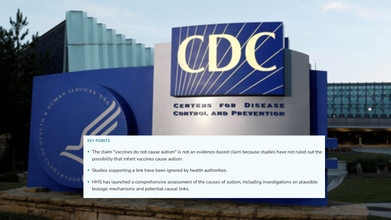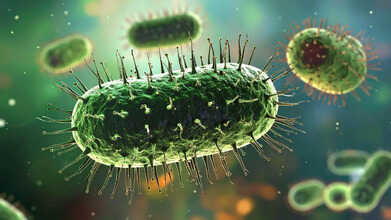- Health Conditions A-Z
- Health & Wellness
- Nutrition
- Fitness
- Health News
- Ayurveda
- Videos
- Medicine A-Z
- Parenting
Ozempic Came From A Monster’s Venom-The Creature That Made Weight Loss A Trend

Image Credit: Canva
Ozempic has stormed the world, grossing billions and becoming a household name not only for controlling blood sugar but also for its dramatic weight-loss effect. But before it was a celebrity-favored fad, its beginnings were anything but glamorous. This medical wonder has its roots in an unexpected place: a toxic desert lizard with a remarkable talent for living on a few meals a year—the Gila monster.
The Gila monster (Heloderma suspectum), which inhabits the deserts of North America, is famous for its slow movements and highly toxic venom. Its bite is lethal enough to kill small animals and inflict extreme pain on humans. But lurking in this venom was a breakthrough that led to Ozempic. Researchers examining the venom of the Gila monster discovered that it consisted of a novel hormone that delays digestion and modulates blood glucose levels—an advantage that enables the lizard to get by on a meager diet.
Also Read: Ozempic Users Found To Age Back By More Than 3 Years, Finds New Trial; Peer Review Pending
In the early 21st century, endocrinologist Daniel Drucker asked for a hormone that mimicked the appetite-inhibiting and blood sugar-controlling action of human glucagon-like peptide-1 (GLP-1) yet would not be quickly broken down in the body. He was prompted by the research of scientists John Eng, Jean-Pierre Raufman, and John Pisano, who had cloned the proteins in Gila monster venom and found two similar in structure to human GLP-1.
Drucker and his colleagues at the University of Toronto obtained a Gila monster from the Utah Zoo breeding program to further study its distinctive biochemistry. Their work identified Exendin-4, a protein that closely resembled GLP-1 but persisted much longer in the blood. This discovery ultimately gave rise to synthetic GLP-1 agonists, transforming the treatment of type 2 diabetes and, more recently, obesity.
Though promising, it took decades before the discovery found its way into an FDA-approved drug. The initial GLP-1 agonist based on Gila monster venom was approved to treat diabetes in 2005. The two decades that followed saw the formulation of more advanced drugs such as semaglutide, which is the active component in Ozempic and its weight loss equivalent, Wegovy.
Also Read: What Is Ozempic Smell? Another Unusually Side Effect Your Weight-Loss Injection Might Come With
Now, millions depend on Ozempic to control diabetes and shed pounds, with demand so great that worldwide shortages have been reported. Its popularity has created a surge in off-label use, with social media spreading trends of dramatic weight loss among celebrities and influencers. But the tale of Ozempic is only one illustration of how nature's most toxic animals have led to life-saving medical breakthroughs.
Other Drugs that Came from Poisonous Animals
Ozempic is hardly the first life-saving medication to be developed from the animal world's toolkit of toxins. From the beginning of time, scientists have turned to nature to find answers to human illnesses, and in the process, have developed some of the most crucial medical advances.
One of the highest-selling medicines in the world, Lisinopril, has its roots in the Brazilian viper (Bothrops jararaca). The venom from the snake includes enzyme inhibitors that inhibit the blood of its prey from clotting so the venom can travel quickly. Researchers took this process and developed angiotensin-converting enzyme (ACE) inhibitors, which decrease blood pressure and are commonly used to treat heart disease and hypertension.
Far down in the ocean, the Caribbean sea sponge (Tectitethya crypta) has been secretly making substances that defend it from foreign DNA brought by predators and prey. Those unusual nucleosides were the foundation for cytarabine, a drug used to treat leukemia and non-Hodgkin's lymphoma through chemotherapy. This discovery reaffirmed the belief that even the most basic life forms can be the solution to revolutionary cures.
In a breathtaking illustration of the paradoxical position of nature in medicine, deathstalker scorpion venom (Leiurus quinquestriatus) brought about the solution to the treatment of brain tumors. A team led by oncologist Jim Olson found that a peptide found in the venom, chlorotoxin Cy5.5, attaches itself only to brain tumor cells and leaves healthy tissue intact. This resulted in the creation of Tozuleristide, a fluorescent tag that aids surgeons in precise identification and resection of cancerous tissue.
The popularity of Ozempic and other venom-based medications indicates the yet unutilized potential of the biochemistry of nature. From fungal-sourced antibiotics to animal-venom-derived painkillers, researchers are learning every day about the possibilities for leveraging the might of nature. Researchers now search for potential new treatments for neurological conditions, pain, and heart disease from the spider venom, cone snail toxin, and even the bat's saliva.
But these findings are also a harsh reminder that most of these species are threatened by habitat loss, climate change, and human use. The Gila monster, for instance, is threatened by land development and wildlife trade. Conservation of these species and their habitats is not only a conservation issue, it is an issue of future medical advancement as well.
Scientists Are 'Freaking Out' After CDC Revives Long Debunked Claim Linking Vaccine With Autism

Credits: CDC
"We just saw it, and everyone is freaking out," told one scientists to the Washington Post on account of anonymity on seeing the Centers for Disease Control and Prevention (CDC) update its website backpedaling on the link between vaccines and autism. The said link had long been debunked, however, the Health Secretary Robert F Kennedy Jr. has echoed the thought, and has a long history of critiquing vaccines and linking it to autism.
The agency's website was updated on Thursday and under Autism and Vaccine, it notes: 'The claim "vaccines do not cause autism" is not an evidence-based claim because studies have not ruled out the possibility that infant vaccine cause autism.'
The first header reads: 'Vaccine do not cause autism', the reason the header has not been removed is all thanks to an agreement with the chair of the US Senate Health, Education, Labor, and Pension Committee that it would remain on the CDC website, as per the website.
As the Post reported, the scientists did not have any prior information about the changes to the website, neither were they consulted for it. Before the Wednesday update, the CDC website stated that studies have shown that there is "no link" between vaccines and developing autism in infants. The website previously stated that "no links" have been found between any vaccine ingredients and disorders.
Read: CDC Plans Vaccine-Autism Study Despite Scientific Consensus
The CDC's Claim: Autism and Vaccine Link
As per the CDC website, approximately 1 in 2 surveyed parents of autistic children believe vaccines played a role in their child's autism. For this, the CDC cites a 2006 survey published in the Journal of Developmental and Behavioral Pediatrics. The CDC notes that these vaccines are often those that the child receives in the first six months of life, including Diphtheria, tetanus, pertussis (DTaP), Hepatitis B (HepB), Haemophilus influenzae type B (Hib), Poliovirus, inactivated (IPV), and Pneumococcal conjugate (PCV) and one given at or after the first year of life (Measles, mumps, rubella (MMR)).
According to CDC a timeline has been provided that shows the correlation between the prevalence in autism cases and higher doses of the above mentioned vaccines. In 1986, the CDC recommended five infant vaccine doses: two oral polio (OPV) doses and three DTP injections. By 2025, the schedule expanded to include multiple doses of rotavirus, HepB, DTaP, Hib, PCV, IPV, influenza, and, at 12 months, MMR, varicella, and HepA.
Autism rates have risen since the 1980s, and while this trend coincides with an increase in recommended childhood vaccines, correlation alone does not establish causation. Autism is believed to have multiple contributing factors, and some researchers have examined possible environmental links. One study reported a statistical correlation between aluminum adjuvants and autism prevalence.
Read: Fact Check: Does Aluminum In Vaccines Cause Food Allergies As RFK Jr Claims?
While the CDC notes that correlation does not prove causation it also mentions that "it does merit further study".
What Are The Scientists Saying?
“CDC cannot currently be trusted as a scientific voice,” said Demetre Daskalakis, who formerly led the agency’s center responsible for respiratory viruses and immunizations. He resigned in August. “My question is, how language that misrepresents decades of research ended up on a CDC website,” said Debra Houry, the CDC’s former chief medical officer who also resigned in August.
However, the spokesman for the Department of Health and Human Services that oversees the CDC, Andrew Nixon, said, "We are updating the CDC’s website to reflect gold standard, evidence-based science.”
The Origin Of This Vaccine-Autism Theory
This originated from now debunked 1998 study, which was retracted after its author, Andrew Wakefield, was found guilty of professional misconduct and barred from practicing medicine in the UK. Despite decades or research no such link could be proven, however, the claim still continues in the political and public discourse.
Kennedy, who had long been anti-vaxxer, also made numerous claims, even though studies have long debunked this theory.
Many years of extensive study has shown that there is no real connection between vaccines and autism. As per a 2019 study, which was conducted over a decade in Denmark, involving half a million children, confirmed that the measles, mumps and rubella (MMR) vaccine does not increase any risk of autism. Other studies too have confirmed the same, being studied over large sample sizes. It had reinforced the medical consensus that vaccines are safe and essential for public health.
First Flu Death of the Season Reported in L.A. County — Health Officials Urge Vaccination

Credits: Canva
Los Angeles County has recorded its first flu-related death of the season, the LA County Department of Public Health announced Wednesday.
The individual was an “older adult” with pre-existing health conditions. Officials noted that the person had likely not received a flu vaccine for this season, which generally spans from October through May.
Although flu cases are still low in November, health authorities expect the number of infections to rise as holiday travel and indoor gatherings increase.
First Flu Death In LA County
"The LA County Department of Public Health reported Wednesday the first flu-related death of the season in Los Angeles County. “We extend our condolences to the family and loved ones of the deceased. This sad loss underscores the serious risks posed by influenza,” said Dr. Muntu Davis, Los Angeles County health officer, in a news release.
Flu activity remains low for now, but it is anticipated to climb around Thanksgiving and the broader holiday period, when travel and indoor events are more common.
Experts advise getting vaccinated at least two weeks before holiday travel or gatherings, since it takes time for immunity to develop.
They also recommend wearing a properly fitted mask in crowded indoor settings, particularly for households with older adults, children under five, or pregnant women.
Flu Shot Guidelines and Eligibility
The Centers for Disease Control and Prevention (CDC) recommends that everyone aged six months and older receive an annual influenza vaccine, with rare exceptions for specific medical conditions. Annual vaccination is especially important for high-risk groups, including:
- Older adults, particularly those aged 65 and above
- Young children under five, especially under two years
- Pregnant individuals
- People with chronic medical conditions such as asthma, diabetes, or heart disease
- Residents of long-term care facilities
Timing: The ideal time to get a flu shot is before flu activity peaks, usually in early fall. It takes about two weeks after vaccination for the body to build full immunity, so getting vaccinated before holiday travel and gatherings is crucial.
Flu Shot: Types of Vaccines
Several flu vaccines are available, including standard-dose, high-dose for older adults, and nasal spray options for certain age groups. Your healthcare provider can recommend the most appropriate option based on age, health status, and any contraindications.
Flu vaccines are generally safe. Mild side effects like soreness at the injection site, low-grade fever, or fatigue may occur, but serious reactions are extremely rare. Individuals with severe allergies to vaccine components should consult their healthcare provider before vaccination.
Even after vaccination, preventive measures such as frequent handwashing, wearing masks in crowded indoor spaces, and avoiding contact with sick individuals can help reduce flu transmission.
CDC Updates Guidance, Notes Possible Vaccine-Autism Link On Website

Credits: Canva/CDC
The U.S. Centers for Disease Control and Prevention is promoting a long-debunked theory, suggesting a potential link between vaccines and autism, and claiming that studies supporting this connection “have been ignored by health authorities.”
CDC Pushes Controversial Vaccine-Autism Theory
The disputed theory appeared on a revised section of the CDC’s website under “Autism and Vaccines” on Wednesday. The website now states: “The statement ‘Vaccines do not cause autism’ is not an evidence-based claim. Scientific studies have not ruled out the possibility that infant vaccines contribute to the development of autism.
However, this statement has historically been shared by the CDC and other federal health agencies within HHS to prevent vaccine hesitancy.” The agency added that the U.S. Department of Health and Human Services has “launched a thorough review of the causes of autism, including investigations on plausible biological mechanisms and potential causal links.”
It also noted, “This webpage will be updated with gold-standard science.” Prior to Wednesday, the page stated there is “no link” between vaccines and autism, and no vaccine ingredients were connected to the condition, according to archived versions cited by The Washington Post.
CDC Faces Criticism
Another part of the site, “About Vaccines for Your Children,” last updated in August 2024, still asserts, “Scientific studies and reviews continue to show no relationship between vaccines and autism.” Dr. Demetre Daskalakis, a former CDC official who resigned earlier this year as head of the National Center for Immunization and Respiratory Diseases, criticized the changes, saying on X, “The weaponization of the voice of CDC is getting worse. DO NOT TRUST THIS AGENCY. This is a national embarrassment.” Despite the new language, the header “Vaccines do not cause autism” remains due to an agreement with Sen. Bill Cassidy (R-La.), chair of the Senate Health Committee, who cast the deciding vote to advance Health Secretary Robert F. Kennedy Jr.’s nomination to the full Senate floor.
CDC Staff Shocked
The revisions surprised CDC staff, including those overseeing vaccine safety and autism information, leaving them blindsided, according to The Post. “We just saw it, and everyone is freaking out,” one scientist said, as per NBC News.
While the changes could undermine public confidence in vaccines, Kennedy and Trump have historically supported this theory. Both have also warned against Tylenol use during pregnancy, claiming a link to autism, despite large-scale studies disproving any connection.
What Is The Vaccine And Autism Link About?
Autism spectrum disorder, or autism, is a condition that affects the brain, making it challenging for some people to communicate and interact with others. Experts still don’t fully understand what causes it.
The idea that vaccines might play a role largely began with a 1998 study suggesting that the MMR (measles-mumps-rubella) vaccine—or infection with the natural measles virus—could lead to autism. Since then, numerous scientific studies have shown there is no connection between vaccines or any of their ingredients and autism.
The 1998 study itself was later discredited: the research was found to be false, the doctor responsible lost his medical license, and the journal that published the paper retracted it, acknowledging it should never have been published.
Despite strong evidence showing vaccines are safe and effective, some parents still choose to delay or skip vaccinations for their children. This can be very dangerous, as diseases like measles, which vaccines prevent, are still circulating. An unvaccinated child who contracts one of these illnesses can become seriously ill or even die and may also put others at risk.
While mild reactions like a fever or rash can occur after vaccination, the chance of a serious side effect from the MMR or other recommended vaccines is very small compared to the risks of the diseases they protect against.
© 2024 Bennett, Coleman & Company Limited

